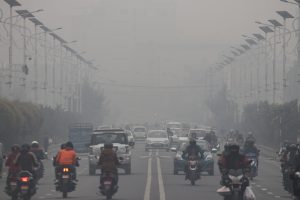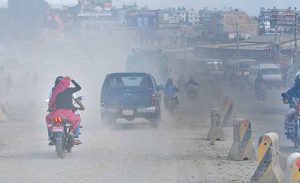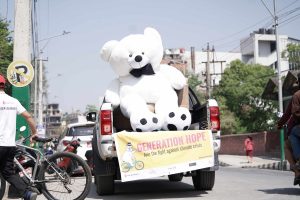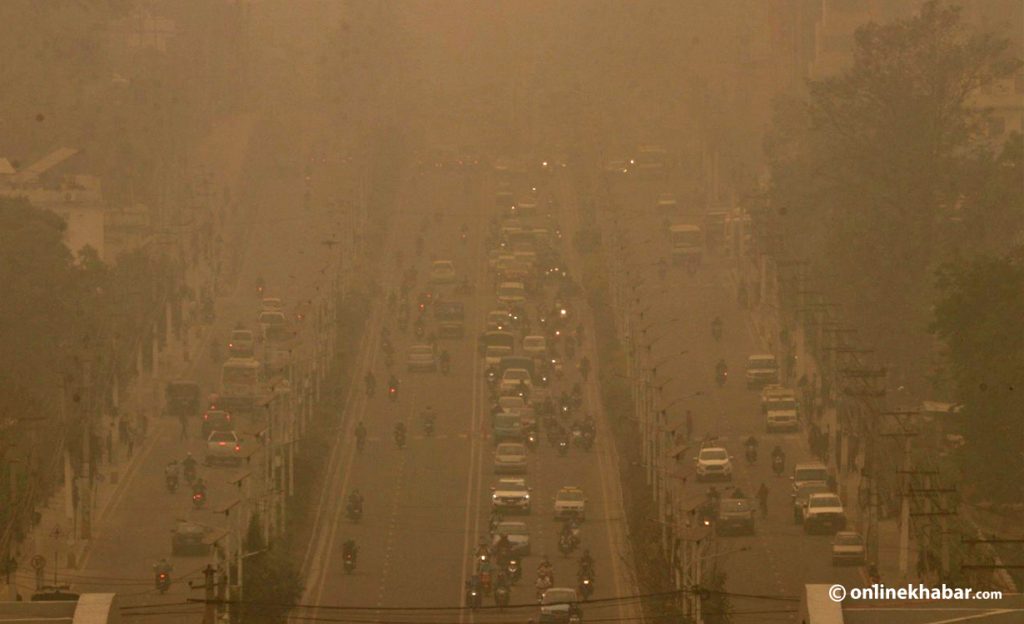
Air pollution has emerged as a global crisis, with severe consequences for public health and the environment. In particular, Kathmandu, the capital of Nepal, is grappling with the devastating effects of poor air quality. The once serene and picturesque valley has succumbed to a blanket of toxic smog and haze, posing a significant threat to the well-being of its residents and the surrounding ecosystem.
So what are the key causes and consequences of poor air quality in Kathmandu? Let’s discuss here and learn about the urgency of addressing this pressing issue.
Causes of poor air quality in Kathmandu
Poor air quality in Kathmandu is the result of a combination of various factors, including rapid urbanisation, industrial growth, vehicular emissions, and household pollution. Understanding the causes of poor air quality (or air pollution) is crucial in devising effective strategies to mitigate its impact.
Here are the primary causes of air pollution in Kathmandu.
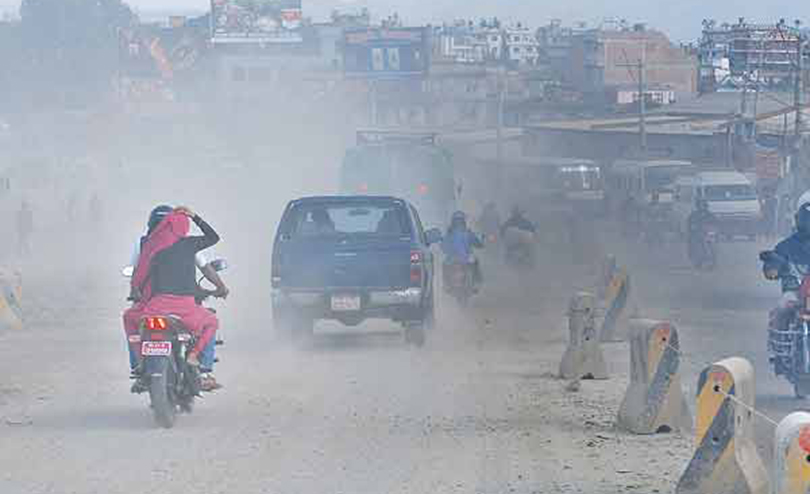
Vehicular emissions
The rapid increase in the number of vehicles on Kathmandu’s roads is a major contributor to poor air quality in Kathmandu. The city’s narrow and congested streets, coupled with inadequate public transportation infrastructure, have led to a surge in private vehicle ownership. The outdated vehicle emission standards, lack of regular vehicle maintenance, and the prevalence of older, high-polluting vehicles significantly contribute to the release of pollutants. Carbon monoxide (CO), nitrogen oxides (NOx), particulate matter (PM), and volatile organic compounds (VOCs) emitted by vehicles degrade air quality in Kathmandu and pose health risks.
Industrial activities
The growth of industries, particularly brick kilns and factories, without proper pollution control measures has further aggravated air quality in Kathmandu. Many of these industries operate without adequate emission control technologies, releasing high levels of pollutants into the atmosphere. Sulfur dioxide (SO2), nitrogen oxides (NOx), particulate matter (PM), and other hazardous substances emitted from these sources contribute to poor air quality in the city.
Household pollution
Burning biomass fuels, such as wood, agricultural residues, and animal dung, for cooking and heating purposes, is a prevalent practice in Kathmandu. Many households rely on traditional stoves and open fires, which burn inefficiently and release large amounts of pollutants. The combustion of biomass fuels produces carbon monoxide (CO), particulate matter (PM), volatile organic compounds (VOCs), and other harmful gases, significantly damaging both indoor and outdoor air quality in Kathmandu.
Construction and dust
The booming construction industry in Kathmandu has resulted in high levels of dust pollution. Construction activities generate large amounts of dust particles that remain suspended in the air. Dust from construction sites, unpaved roads, and excavation work contribute to the presence of particulate matter (PM) in the atmosphere. Additionally, the lack of proper dust control measures exacerbates the problem, leading to poor air quality in Kathmandu.
Topography and weather conditions
The topography and weather conditions of Kathmandu valley also contribute to poor air quality in Kathmandu. The valley is surrounded by hills and mountains, which act as natural barriers, limiting the dispersion of pollutants. During the winter months, temperature inversions occur, trapping pollutants close to the ground and further deteriorating air quality. These factors exacerbate the impact of pollution sources within the valley.
Consequences of poor air quality in Kathmandu
Poor air quality in Kathmandu has far-reaching consequences, impacting various aspects of public health, the environment, and the overall well-being of its residents. The deteriorating air quality poses significant risks and demands urgent attention.
Here are some of the key consequences of air pollution in Kathmandu.

Health impacts
The foremost and most direct impact of poor air quality in Kathmandu is on public health. Prolonged exposure to high levels of pollutants in the air has been linked to a range of health problems. Respiratory illnesses, such as asthma, bronchitis, and chronic obstructive pulmonary disease (COPD), are prevalent among individuals exposed to polluted air. The inhalation of particulate matter (PM), nitrogen dioxide (NO2), sulfur dioxide (SO2), and other pollutants can lead to inflammation of the airways, reduced lung function, and respiratory infections. Moreover, air pollution increases the risk of cardiovascular diseases, including heart attacks, strokes, and high blood pressure. Vulnerable groups such as children, the elderly, and individuals with pre-existing respiratory or cardiovascular conditions are particularly susceptible to these health impacts.
Reduced quality of life
Poor air quality in Kathmandu has a profound impact on the overall quality of life of residents. The persistent presence of smog and haze diminishes visibility, limiting scenic views and impacting tourism. Additionally, the discomfort caused by polluted air, such as eye irritation, coughing, and difficulty breathing, hampers daily activities and reduces productivity. People may experience fatigue, reduced concentration, and decreased physical activity levels, negatively affecting their well-being and quality of life.
Environmental degradation
Poor air quality in Kathmandu not only affects human health but also causes significant damage to the environment. The release of pollutants into the air contributes to environmental degradation and ecosystem disruption. Forests surrounding Kathmandu, including the critical ecosystems of the Himalayan mountain range, suffer from the deposition of pollutants, leading to forest decline and loss of biodiversity. Air pollution also affects agricultural productivity by contaminating soil and water resources. The deposition of pollutants on crops and vegetation can result in reduced yields and compromised food security.
Climate change
Air pollution, particularly the release of greenhouse gases, contributes to climate change. The emission of carbon dioxide (CO2) and other greenhouse gases from various pollution sources, including vehicles, industries, and biomass burning, contributes to the warming of the planet. Climate change has a range of adverse impacts, including rising temperatures, changing weather patterns, and increased frequency and intensity of extreme weather events. These changes further exacerbate the challenges faced by Kathmandu and its residents, affecting water resources, agriculture, and overall resilience to climate-related risks.
Economic consequences
The consequences of poor air quality in Kathmandu also extend to the economic sphere. The healthcare costs associated with treating air pollution-related illnesses, including hospital admissions, medication, and lost productivity, place a significant burden on individuals and the healthcare system. Furthermore, the impact on tourism and outdoor recreational activities, which are important sources of revenue for Kathmandu, can be substantial. The presence of polluted air and diminished scenic beauty may discourage visitors, leading to a decline in tourism revenue.
Potential solutions
The consequences of poor air quality in Kathmandu are multi-faceted and interconnected, affecting not only public health but also the environment, climate, and economy. Addressing air pollution requires comprehensive strategies and concerted efforts from all stakeholders.
By prioritising clean air and implementing effective measures, Kathmandu can protect the health and well-being of its residents and ensure a sustainable future for the city. Kathmandu can take several measures to mitigate air pollution and improve the overall air quality in the city.
Here are some potential solutions to the poor air quality in Kathmandu.
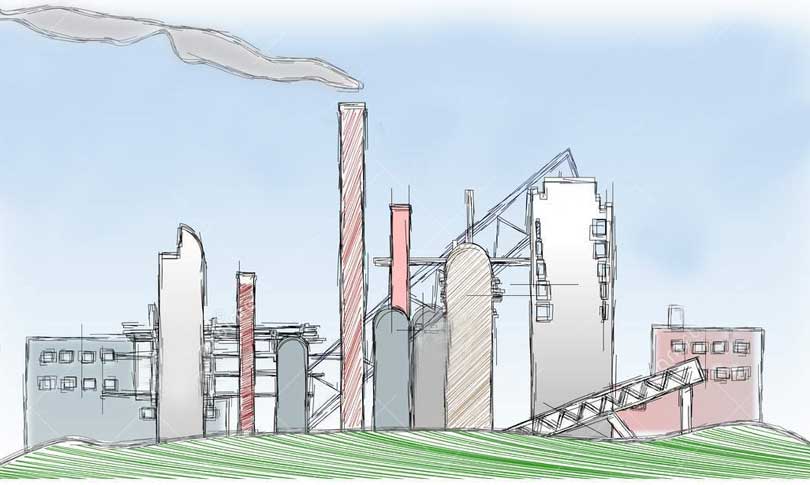
Strengthening transportation systems
Improve public transportation: Invest in expanding and modernising the public transportation system, including buses and electric vehicles. This will provide affordable and efficient alternatives to private vehicles, reducing traffic congestion and emissions.
Encourage non-motorised transportation: Develop dedicated bicycle lanes and pedestrian-friendly infrastructure to promote walking and cycling as viable modes of transportation. This will help reduce the reliance on motorised vehicles for short-distance travel.
Implementing stricter emission standards
Enforce stricter emission standards for vehicles: Implement and enforce regulations that require vehicles to meet higher emission standards. This includes regular emission testing and inspections to ensure compliance.
Promote electric and hybrid vehicles: Provide incentives such as subsidies and tax benefits to promote the adoption of electric and hybrid vehicles. Establish the necessary infrastructure, such as charging stations, to support the widespread use of electric vehicles.
Controlling industrial emissions
Strengthen regulations and enforcement: Ensure that industries adhere to pollution control measures and implement regular monitoring of industrial emissions. Strictly enforce penalties for non-compliance to discourage industrial pollution, a major source of poor air quality in Kathmandu.
Promote cleaner production techniques: Encourage industries to adopt cleaner technologies and practices that minimise emissions and reduce environmental impact. Provide incentives for the implementation of pollution control equipment and energy-efficient processes.
Promoting clean cooking and heating practices
Encourage clean cooking solutions: Raise awareness about the health hazards of traditional stoves and promote the use of clean and efficient cooking technologies such as improved cookstoves or induction cookers. Provide subsidies or financial incentives to make clean cooking solutions more accessible.
Promote renewable energy for heating: Encourage households to switch from traditional biomass fuels to renewable energy sources such as biogas, solar water heaters, or electric heating. Raise awareness about the benefits of cleaner heating practices and provide support for the installation of renewable energy systems.
Enhancing waste management
Improve waste management practices: Strengthen waste management systems to reduce open burning and improper disposal of waste. Promote recycling and composting to minimise the amount of waste that goes to landfills, reducing the release of pollutants into the air that result in poor air quality in Kathmandu.
Encourage waste-to-energy projects: Explore the feasibility of waste-to-energy projects that can convert organic waste into usable energy. This can help reduce the reliance on fossil fuels and contribute to cleaner energy generation.
Raising awareness and community engagement
Conduct public awareness campaigns: Educate the public about the health impacts of air pollution and the importance of individual actions in reducing pollution levels. Promote behaviour changes such as reducing vehicle usage, conserving energy, and adopting sustainable practices in households and industries.
Foster community engagement: Encourage community-led initiatives such as tree planting drives, neighbourhood clean-up programmes, and anti-pollution rallies. Engage citizens, schools, and local organisations to take an active role in promoting clean air and creating a sense of collective responsibility.






